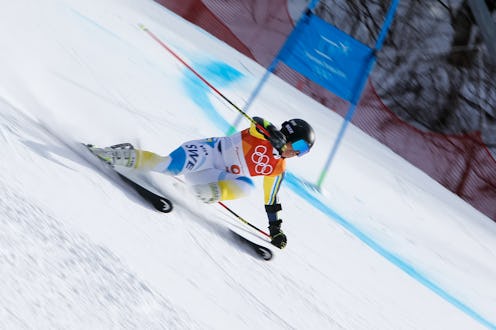News
What Sets The Alpine Skiing Events Apart, So You Can Watch Like A Pro

Team USA had a big Olympic victory Wednesday night when skiing superstar Mikaela Shiffrin won the gold medal in giant slalom. But she's just gotten started and the two-time gold medalist hopes to keep up her winning streak when she goes into her second and best event tomorrow, the slalom competition. If you're a casual viewer who only watches these races every four years at the Winter Olympics, you might be wondering what's the difference between the slalom and giant slalom — or all the alpine skiing events for that matter.
Shiffrin will be back on the slopes on Thursday to make her next medal run. Then there's all of Shiffrin's ski races next week, which include the downhill competition with teammate and decorated veteran Lindsey Vonn. As you get ready again to root for Shiffrin and her teammates in their quest for gold, now would be a good time to brush up on your alpine skiing 101.
In the slalom, competitors ski between sets of poles — known as gates —that are spaced apart at a certain distance. In the giant slalom, the gates are spaced further apart.
Each skier makes two runs down the course, the times are added up, and the winner is the one with the fastest cumulative time. A combination of a draw and Alpine Ski World Cup circuit standings determine the order in which the skiers compete in the first run. (Heading into the giant slalom and slalom, Shiffrin is ranked third and first in the world cup circuit.) For the second run, the order of the top 30 skiers are reversed so that the 30th ranked skier goes first.
As skiers are hurdling down the slope, they must pass the tips of both skis and their feet between the two poles forming the gate. The men's course has 55 to 75 gates while the women's course has 40 to 60. The vertical drop is also steeper for men than women.
If you've been watching the recent races, you'll notice oftentimes the skiers knock the poles because they're making turns so tight. Hitting the gates isn't a rule, but it is a strategic move that skiers use to take the most direct route with the tightest and narrowest turns possible. Those split seconds can mean all the difference — Norway's Ragnhild Mowinckel barely clipped Italy's Federica Brignone for the silver medal on Wednesday with a combined time of 2:20:413. Brignone got the bronze with 2:20.48.
These two events are part of the five disciplines of alpine skiing in the Winter Olympics for men and women, plus one team competition.
In the super-G, which stands for super giant slalom, the gates are spaced the furthest apart. The super-G is considered the middle-distance gateway between the giant slalom, which focuses on the skier's technical ability to make sharp turns, to the downhill, which focuses on speed.
Arguably the most dangerous of the five disciplines, the downhill course is the longest course, with the biggest vertical drop, and gates spaced the furthest apart. Olympic skiers have to be fast and can reach speeds of up to 95 mph — compared to the recreational skier who averages 20 to 40 mph. For both the super-G and downhill races, competitors will only get one run.
While skiers tend to dominate one or two disciplines over the others, both require speed and technical skills. The combined event, also known as the super combined, gives skiers a chance to use both — one run down a shortened downhill course and a second run on a slalom slope. The times are added up to determine the winner.
Finally, this year at PyeongChang, skiers will have the chance to compete in the first alpine skiing team event at the Olympics. Two men and two women will represent each of the 16 countries, who will compete head to head in a knockout format tournament with four rounds.
You can keep track of all the alpine skiing events schedule and medals here on the International Ski Federation website.